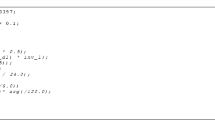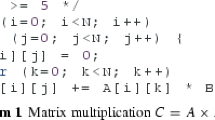Abstract
We present symbolic methods to improve the precision of static analyses of modular integer expressions based on Abstract Interpretation. Like similar symbolic methods, the idea is to simplify on-the-fly arithmetic expressions before they are given to abstract transfer functions of underlying abstract domains. When manipulating fixed-length integer data types, casts and overflows generally act like modulo computations which hinder the use of symbolic techniques. The goal of this article is to formalize how modulo operations can be safely eliminated by abstracting arbitrary arithmetic expressions into sum, product, or division of linear forms with integer coefficients, while simplifying them. We provide some rules to simplify arithmetic expressions that are involved in the computation of linear interpolations, while ensuring the soundness of the transformation.
All these methods have been incorporated within the Astrée static analyzer that checks for the absence of run-time errors in embedded critical software, but also in an available toy abstract interpreter. The effects of our new abstract domain are then evaluated on several code excerpts from industrial code.
Access this chapter
Tax calculation will be finalised at checkout
Purchases are for personal use only
Similar content being viewed by others
Notes
- 1.
that is to say
 for every set
for every set
 .
.
References
Blanchet, B., et al.: Design and implementation of a special-purpose static program analyzer for safety-critical real-time embedded software. In: Mogensen, T.Æ., Schmidt, D.A., Sudborough, I.H. (eds.) The Essence of Computation. LNCS, vol. 2566, pp. 85–108. Springer, Heidelberg (2002). https://doi.org/10.1007/3-540-36377-7_5
Blanchet, B., et al.: A static analyzer for large safety-critical software. In: Programming Language Design and Implementation. ACM (2003). https://doi.org/10.1145/781131.781153
Boillot, J., Feret, J.: Artifact for “symbolic transformation of expressions in modular arithmetic” (2023). https://doi.org/10.5281/zenodo.8186873
Cousot, P., Cousot, R.: Static determination of dynamic properties of programs. In: International Symposium on Programming. Dunod (1976). https://doi.org/10.1145/390019.808314
Cousot, P., Cousot, R.: Abstract interpretation: a unified lattice model for static analysis of programs by construction or approximation of fixpoints. In: Principles of Programming Languages. ACM (1977). https://doi.org/10.1145/512950.512973
Cousot, P., Cousot, R.: Abstract interpretation and application to logic programs. J. Log. Program. (1992). https://doi.org/10.1016/0743-1066(92)90030-7
Cousot, P., Cousot, R.: Comparing the Galois connection and widening/narrowing approaches to abstract interpretation. In: Bruynooghe, M., Wirsing, M. (eds.) PLILP 1992. LNCS, vol. 631, pp. 269–295. Springer, Heidelberg (1992). https://doi.org/10.1007/3-540-55844-6_142
Cousot, P., Halbwachs, N.: Automatic discovery of linear restraints among variables of a program. In: Principles of Programming Languages. ACM (1978). https://doi.org/10.1145/512760.512770
Cytron, R., Ferrante, J., Rosen, B.K., Wegman, M.N., Zadeck, F.K.: Efficiently computing static single assignment form and the control dependence graph. Trans. Program. Lang. Syst. 13, 451–490 (1991). https://doi.org/10.1145/115372.115320
Gallois-Wong, D.: Formalisation en Coq des algorithmes de filtre numérique calculés en précision finie. (Coq formalization of digital filter algorithms computed using finite precision arithmetic). Ph.D. thesis, University of Paris-Saclay, France (2021). https://tel.archives-ouvertes.fr/tel-03202580
Granger, P.: Static analysis of arithmetical congruences. Int. J. Comput. Math. 30, 165–190 (1989). https://doi.org/10.1080/00207168908803778
Granger, P.: Static analysis of linear congruence equalities among variables of a program. In: Abramsky, S., Maibaum, T.S.E. (eds.) CAAP 1991. LNCS, vol. 493, pp. 169–192. Springer, Heidelberg (1991). https://doi.org/10.1007/3-540-53982-4_10
Halbwachs, N., Péron, M.: Discovering properties about arrays in simple programs. In: Programming Language Design and Implementation. ACM (2008). https://doi.org/10.1145/1375581.1375623
ISO: International Standard ISO/IEC 9899:1999. International Organization for Standardization (2007). http://www.open-std.org/jtc1/sc22/wg14/www/docs/n1256.pdf
Jeannet, B., Miné, A.: Apron: a library of numerical abstract domains for static analysis. In: Bouajjani, A., Maler, O. (eds.) CAV 2009. LNCS, vol. 5643, pp. 661–667. Springer, Heidelberg (2009). https://doi.org/10.1007/978-3-642-02658-4_52
Journault, M., Miné, A., Monat, R., Ouadjaout, A.: Combinations of reusable abstract domains for a multilingual static analyzer. In: Chakraborty, S., Navas, J.A. (eds.) VSTTE 2019. LNCS, vol. 12031, pp. 1–18. Springer, Cham (2020). https://doi.org/10.1007/978-3-030-41600-3_1
Logozzo, F., Fähndrich, M.: Pentagons: a weakly relational abstract domain for the efficient validation of array accesses. In: Symposium on Applied Computing. ACM (2008). https://doi.org/10.1016/j.scico.2009.04.004
Masdupuy, F.: Array abstractions using semantic analysis of trapezoid congruences. In: International Conference on Supercomputing. ACM (1992). https://doi.org/10.1145/143369.143414
Miné, A.: A new numerical abstract domain based on difference-bound matrices. In: Danvy, O., Filinski, A. (eds.) PADO 2001. LNCS, vol. 2053, pp. 155–172. Springer, Heidelberg (2001). https://doi.org/10.1007/3-540-44978-7_10
Mine, A.: The octagon abstract domain. In: Proceedings Eighth Working Conference on Reverse Engineering. IEEE Computer Society (2001). https://doi.org/10.1109/WCRE.2001.957836
Miné, A.: Symbolic methods to enhance the precision of numerical abstract domains. In: Emerson, E.A., Namjoshi, K.S. (eds.) VMCAI 2006. LNCS, vol. 3855, pp. 348–363. Springer, Heidelberg (2005). https://doi.org/10.1007/11609773_23
Müller-Olm, M., Seidl, H.: Analysis of modular arithmetic. In: Sagiv, M. (ed.) ESOP 2005. LNCS, vol. 3444, pp. 46–60. Springer, Heidelberg (2005). https://doi.org/10.1007/978-3-540-31987-0_5
Simon, A., King, A.: Taming the wrapping of integer arithmetic. In: Nielson, H.R., Filé, G. (eds.) SAS 2007. LNCS, vol. 4634, pp. 121–136. Springer, Heidelberg (2007). https://doi.org/10.1007/978-3-540-74061-2_8
Venet, A.J.: The gauge domain: scalable analysis of linear inequality invariants. In: Madhusudan, P., Seshia, S.A. (eds.) CAV 2012. LNCS, vol. 7358, pp. 139–154. Springer, Heidelberg (2012). https://doi.org/10.1007/978-3-642-31424-7_15
Acknowledgements
We thank the anonymous referees for their constructive comments and suggestions. Furthermore, we extend our gratitude to Josselin Giet, Marc Chevalier and Antoine Miné for granting us permission to publish a toy abstract interpreter they created, which served as the foundation for our artifact.
Author information
Authors and Affiliations
Corresponding author
Editor information
Editors and Affiliations
Rights and permissions
Copyright information
© 2023 The Author(s), under exclusive license to Springer Nature Switzerland AG
About this paper
Cite this paper
Boillot, J., Feret, J. (2023). Symbolic Transformation of Expressions in Modular Arithmetic. In: Hermenegildo, M.V., Morales, J.F. (eds) Static Analysis. SAS 2023. Lecture Notes in Computer Science, vol 14284. Springer, Cham. https://doi.org/10.1007/978-3-031-44245-2_6
Download citation
DOI: https://doi.org/10.1007/978-3-031-44245-2_6
Published:
Publisher Name: Springer, Cham
Print ISBN: 978-3-031-44244-5
Online ISBN: 978-3-031-44245-2
eBook Packages: Computer ScienceComputer Science (R0)





 for every set
for every set
 .
.